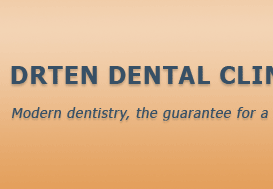| The root treatment |
|
A way to save the tooth from being extracted.
The tooth consists of a crown - that is the visible part of the
tooth in the mouth - and a root which is anchored in the bone.
The root ends in one or more root tips through which the blood
vessels and the nerves enter the tooth. These vessels provide
the tooth with the necessary blood supply while the nerve makes
sure that you notice when the tooth is exposed to cold and
warm and touch stimuli. But this nerve inside the tooth that
reaches through tiny canals up to the crown can also hurt very
badly. This happens when it is infected by caries or bacteria.
Then an inflammation of the nerves develops that in the course
of time will affect the bone. The tooth will become oversensitive
especially during biting and it will loosen so in the end the
extraction of the tooth may become necessary.
|
 |
| To prevent this from happening, your
dentist will recommend you a root treatment. The inflamed tooth
nerve will be replaced, the tooth canals will be widened and
cleaned and provided with a medicament. This can take several
appointments until the inflammation abates completely. Only then
will the root be covered bacteria-proof with a filling material.
Normaly it is useful to provide the tooth with a crown afterwards
for stability reasons.
The filling of the root canal is a good and promising way
to save the tooth from being torn out. The more so, the earlier
the clinical picture is determined and the earlier a treatment
is carried out.
Whether the root canal filling is the appropiate measure
in the respective case is a question your dentist will inform
you about.
|
| Fillings |
|
Tooth-colour fillings (Composite fillings)
As our clinic is "amalgam-free" already
for a long time, we had to answer the question for possible
alternatives for amalgam a long time ago.
Modern tooth-colour filling plastics (also called "composite" because
they are made of a plastic base and anorganic filling substances)
have nowadays reached a high quality level. Mainly in the region
of the front teeth (incisors and canine teeth), but also for
smaller fillings in grinders plastic fillings are today the
therapy of first choice. Because there are composites available
in practically every tooth-colour, in most cases a perfect
aesthetic fitting of the filling is possible. In case of larger
fillings in the region of the grinders the use of composites
may sometimes be problematic and its lifespan is limited. As
a lasting alternative to composites the use of ceramic inlays
should be mentioned here.
|
 |
GC Gradia inlay:
Inlays
Inlays are a special kind of fillings that are mainly used for
grinders. After the old filling or the caries is replaced, an
impression of the defect drilled open is taken. Then, in the
lab an inlay made of gold or ceramics is manufactured which fills
the drilled hole with the highest precision and which restores
the original form of the tooth.
|

 |
 |
Ceramic inlays (Porcelain inlays)
Ceramic inlays are metal-free and therefore translucent. They
are being glued gap-free with a special adhesive technology
into the tooth. In this way a chemical connection between the
tooth and the ceramic is established that gives even weak teeth
the original stability. The aesthetic effect is perfect due
to the hight translucency.
Ceramics are highly biocompatible. There are no known allergies
against them in contrast to the allergies against e.g. certain
metals.
|
 |
Ceramic crowns
A crown is always indicated when a tooth
is destroyed deeply and a reconstruction by means of a filling,
inlay, or veneer is no longer possible. This is especially
the case when
- the defect reaches below the gums
- the tooth root has been treated (dead root)
- the tooth has been fractured deeply
- caries or old fillings are existing extensively around
the tooth
Coat crowns
A coat crown is a ceramic crown with a metal core. Crowns
with a ceramic coat are of high-quality aesthetic and
not to distinguish from own teeth. The ceramic substance
is placed onto the crown frame so it is firmly connected
to the metal base.
Full ceramic crowns
Full ceramic crowns are metal-free and are used increasingly
for critical patients where biocompatible ceramics
comply best with the demand for a very high-quality
aesthetic. Full ceramic crowns are unsurpassed in their
aesthetic effect. The manufacturing of full ceramic
crowns takes some time, they are among the top achievements
of modern dental technology.
|
| Bleaching |
 |
There are two different bleaching technologies:
Home bleaching, that can be carried out by the patient at home.
The patient will wear for ca. 2 weeks at night a transparent
dental splint filled with bleaching gel. This splint was manufactured
before, according to an impression. The teeth will be cleaned
professionally by the dentist, including a scaling treatment.
Please make sure you brush your teeth thoroughky before you
wear the splint. |
Why do teeth discolourate?
- Pigmentation due to smoking, coffee, red wine
- Taking certain drugs
- Due to root treatments
- General aging of teeth
Power bleaching, also called office bleaching. At first,
the teeth are cleaned professionally and, if necessary,
a scaling treatment is carried out. The gums are then covered
with a protective varnish so only the teeth remain open.
After this, the bleaching gel that is activated by light
is put evenly onto the front surface of the teeth. |
| The teeth will then be exposed for 20 minutes
to a lamp that is positioned directly in front of the patient's
mouth and that is emitting a plasma light-radiation. The patient
will wear protective glasses for this. Due to the special nature
of the radiation source almost no annoying warmth is produced.
This procedure is then repeated twice with a fresh bleaching
gel so the whole treatment takes 60 minutes. After the treatment
the gum protection will be removed and the remaining bleachin
gel will be rinsed.
The bleaching gel contains 15% carbamideperoxide.
This substance has proved its reliability for bleaching in
more than 20 years. It sets free hydrogenperoxide that intrudes
the tooth and splits the colour pigment by means of oxidation
into colourless compounds. The bleaching will last for 3 -
5 years, the oral hygiene and the personal way of life of the
patient playing an important role here, of course.
|
|
| Toothaches |
Toothaches can be hammering, sharp, gnawing
or dull, and in cases of inflammations or suppurations the
cheek can swell.
What are the main causes for
toothaches?
Often toothaches are caused by untreated caries. They may
also be caused by inflammations that are situated e.g. at
the root of the tooth or inside the jaw-bone at the root
tip. A paradontitis (an inflammatory disease of the tooth
supporting apparatus), too, can lead to toothaches. Children
whose teeth are breaking through can also be painful, as
parents know from experience. What can I do when I have toothaches?
Arrange an appointment with your dentist for the next possible
date.
|
 |
As a pain patient you will be treated prior
to others. Until you are being treated, analgetic drugs can
soothe your pain.
You should keep the appointment even if the pain should have
abated in the meantime. Because if the tooth is not treated,
the pain will come back eventually.
How can you prevent toothaches?
The right and regular toothcare is important for the health
of your teeth. Therefore brush your teeth at least twice
a day and also use dental floss additionally to clean the
gaps between the teeth where leftovers of your meals can
build up unnoticed. The thorough cleaning, that is the
complete removal of plaque, takes at least three minutes.
- Go to control examinations twice a year!
- Ask your dentist to show you effective brushing techniques.
- A healthy and mostly sugar-free diet improves the dental
health.
- Use fluoride tooth paste.
The right dental care begins already in early childhood. So
teach your child the appropiate oral hygiene and take it
regularly to the dentist. |
|



